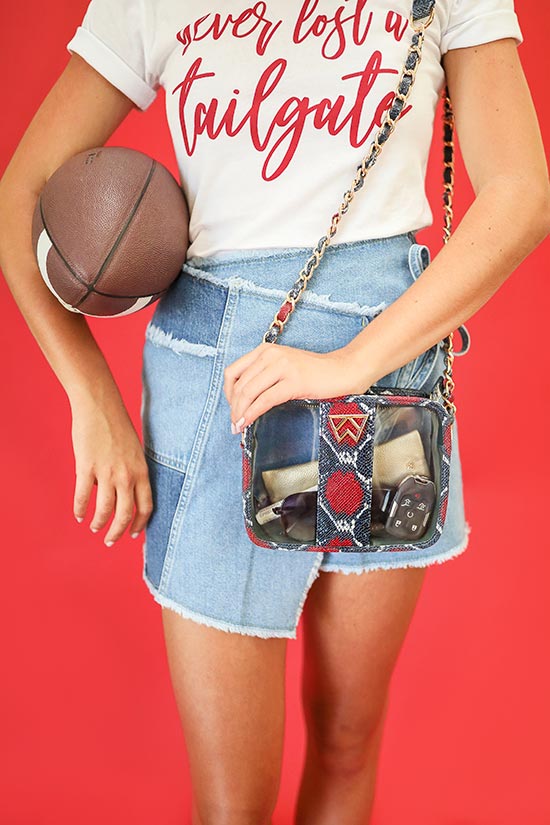“观赛包包”今秋大卖,里面能装些什么?

|
2013年,美国国家橄榄球大联盟(以下简称为“NFL”)更新了带包入场政策,规定在比赛日哪些包能够带进体育场,以及哪些不允许携带。随后,NFL每年都会做出政策微调。目前的规定是,观看NFL橄榄球比赛的普通观众只能够携带跟手一样大的透明手包进场。“全透明”政策改变了游戏规则。 大学橄榄球比赛往往沿用NFL的政策,2016年时十大联盟和Pac 12联盟的多数大学都采用了相同的透明包政策。奥斯汀市的手提包设计师凯莉·韦恩听说东南联盟也要采取同样政策时,首先想到的不是自己的同名钱包系列产品,而是对密西西比大学铁杆校友和球迷的影响。“这样一来会影响我的风格。”她说道,随后解释说美国南部地区的女球迷非常重视自己在看台上的形象,“我们去看橄榄球比赛都会盛装打扮。” 韦恩设计的皮包在美国东南部地区的女性中已经颇受欢迎,而且随着皮包在Instagram的照片里频繁露面,还被贴上专门用于比赛日服装的标签,她该怎么做已经很明显。 于是这位设计师和团队开始高速运作,将通常需要18个月的设计过程压缩为6个月,所以当2017年东南联盟宣布透明包政策时,凯利-韦恩公司在同年7月推出了一款基于其最畅销皮包而设计的透明包。这家公司类似小作坊,运营和生产总监安·伊莱泽·艾伦一度担心首批订单太多,结果一个月内就销售一空,同年年底实现了50%的销量增长。现在,该公司提供六款透明包,在总营收中所占比例约为50%。公司下单数量是当年首批下单的5倍,但“还在担心订单量是否够用”,艾伦说道。 近年来,Hammitt、Truffle Co.和Loeffler Randall等其他公司也推出了时尚前卫(还能带进体育场)的包。对于体育场经营者来说,如果球迷带着装饰球队颜色的时髦透明斜挎包,或者是Ziploc加仑袋进场,基本上就不会在意,只要包的尺寸不大于12 x 6 x 12英寸(30.48厘米x15.24厘米x30.48厘米)就行。 2014年8月,旧金山49人队在加利福尼亚州圣克拉拉新开业的利维体育场进行第一场季前赛时,球队已经花了一年多时间来向季票购买者和球迷介绍政策。球队的体育场总经理吉姆·莫克里奥是NFL体育场安全委员会委员,据他介绍,首赛季49人队在当地进行了轰炸式宣传,从广播和电视广告,到停车场里最偏远的指示牌,再到门票上醒目的文字,都是为了提醒入场观众遵守政策。每年49人队都会继续尽可能多做宣传,希望每位看比赛的人都能够在到场之前知道透明包政策,并相应地做好计划。努力已经取得回报。“我们现在可以准确追踪人们进入体育场所需要的时间。”莫克里奥说道,并指出利维体育场能够确保开球前30分钟让3万人入场。 在帕洛阿尔托沿路周边几英里地区,多数的大学橄榄球迷都已经接受参加大型公共活动带包的新规定,但每年都会有一些坚决不守规定的人,他们总想批驳该政策,争论应该允许带多大的包,有时只是想要发泄愤怒。“真是种冒险”,斯坦福大学的客服总监克里斯·多斯特笑着说道,2016年,斯坦福制定透明包政策时就曾经以NFL的政策为模板。“我们的愿望是,每过一年(球迷)对透明包政策就更加熟悉和配合一些。”多斯特说道,“实际进展还是挺让人欣慰的。” 不过即便是在体育界之外,透明包似乎也取得了一些进展。现在原宿的意见领袖或伦敦东一区肖尔迪奇的博客写手可能会惊讶地发现,自己背的包跟高喊“Roll Tide!”口号的橄榄球迷是一样的。 “90年代的透明包正在卷土重来,成为怀旧运动的一部分。”追踪零售数据的EDITED公司的零售分析师艾弗里·费根说道。“与腰包的卷土重来类似,透明袋现在变成了一种微趋势,主要见于街头服饰。”事实上,过去两年巴黎世家、迈克高仕、香奈儿和Staud等奢侈品品牌设计师纷纷推出了透明包。根据EDITED的数据,透明手提包的到货数量比去年增加了235%,流行到零售商都在提价出售。 但费根说道,2019年秋季和2020年早春的时装秀上并没有多少PVC包,倒是很多缝制动物皮包。“只有时间才可以证明透明包能不能像跟腰包一样成功。”她说道。 但是,对于看比赛日观众来说,带透明包似乎已经成为习惯。凯利-韦恩公司的包此前几乎只有美国南部地区的客户,但去年该公司在诺德斯特龙上线销售,之后订单的地理覆盖范围大幅扩张,尤其是在加州。“我一辈子都没想过自己会因为透明包出名。”这位设计师说道。(财富中文网) 译者:艾伦 审校:夏林 |
In 2013, the NFL announced an update to its bag policy, what you could and could not bring into a stadium on game day, and has continued to fine-tune that policy each year. As it stands, the only bag an average attendee at any NFL football game can bring in is a small clutch, the size of one’s hand, or a clear bag. The “All Clear” policy was a game changer. College football, which is the trickle-down recipient of many NFL policies, followed suit with the majority of the Big Ten and Pac 12 schools adopting the same clear bag policy in 2016. When handbag designer Kelly Wynne, who’s based in Austin, heard the rumblings that the SEC would surely adopt the same policy and soon, her first thought was less for her eponymous purse line, but as a diehard Ole Miss alum and fan. “This is really going to cramp my style,” she said, explaining that Southern female fans care deeply about their appearance in the stands. “We dress up to go to these football games.” Wynne’s leather bags were already popular with women in the Southeast, and as they showed up regularly on Instagram post with hashtags devoted to game day outfits, it was fairly obvious what she needed to do. The designer and her team kicked into high gear, condensing what is normally an 18-month process into six months, so that when the SEC did, in fact, announce its own clear bag policy in 2017, Kelly Wynne brought to market that July a clear bag based on the design of their best-selling leather purse. As a small batch business, Ann Elize Allen, the director of operations and production, was concerned the first order was too big, but they were sold out within a month and had a 50% increase in sales growth by the end of that year. Now the company offers six different clear bags, which account for roughly 50% of total revenue, and their order this year is five times the volume of their first order, “and we are still wondering if we ordered enough,” Allen said. Other companies such as Hammitt, Truffle Co. and Loeffler Randall have also debuted fashion-forward (and stadium compliant) bags in recent years. Stadium operators, for their part, care far less if a fan is carrying a sleek clear crossbody, adorned with tassels in the team’s colors, or a Ziploc gallon bag. So long as its no bigger than 12 x 6 x 12 inches. When the San Francisco 49ers played their first preseason game in August 2014 in the newly opened Levi’s Stadium in Santa Clara, CA, the team had been working for over a year to communicate to its season ticket holders and fans about the policy. Jim Mercurio, the team’s stadium general manager, who also sits on the NFL’s committee for stadium security, said the 49ers spent the first season flooding the zone, as it were, with radio and TV spots, signage that extended to the farthest reaches of the parking lot, prominent printing on the tickets, all to alert game-goers about the policy. Each year, the 49ers continue to advertise the policy as much as possible, the goal being that every person who comes to a game knows about the clear bag policy before they arrive and has planned accordingly. The efforts have paid off. “We are tracking very, very well for how long it takes to get into the facility,” Mercurio said, noting that Levi’s processes 30,000 people into the stadium in the final 30 minutes before kick-off. A few miles up the road in Palo Alto, the majority of college football fans have accepted the new reality of attending large public events, but each year still brings indefatigable outliers, who want to debate the policy, the size of their bag, or to simply register their outrage. “It’s been a real adventure,” laughs Chris Dorst, director of guest services at Stanford. The university viewed the NFL as its roadmap when instituting the policy in 2016. “The expectation with each passing year is [the fans] will be more familiar and comfortable with the clear bag policy,” Dorst said. “We are happy with the way things have gone.” But even beyond the world of sports, clear bags seem to be having a moment. Today’s Harajuku influencer or Shoreditch-based blogger might be rather surprised to find that they share an accessory with someone chanting, “Roll Tide!” “Clear bags are making a comeback from the ‘90s as a part of the nostalgia movement,” Avery Faigen, a retail analyst at EDITED, which tracks retail data, said. “Similar to the fanny pack comeback, clear bags would currently be classified as a micro-trend that’s seen mostly in streetwear.” Indeed, luxury designers like Balenciaga, Michael Kors, Chanel and Staud have all put out transparent bags in the last two years. According to EDITED data, clear handbag arrivals have increased by 235% over the last year, and their popularity is allowing retailers to increase prices. Faigen said, however, that the Fall 2019 and pre-Spring 2020 runway shows were filled not with PVC, but quilted and animal-skinned bags. “Only time will tell if clear bags will follow the same success as the fanny pack,” she said. But for the game-day crowd, the clear look seems here to stay. Last year, Kelly Wynne bags, which previously had an almost exclusively Southern customer base, launched online at Nordstrom and has since seen a major expansion in the geographic reach of its orders, particularly California. “I never in a million years thought I would be known for clear bags,” the designer said. |













